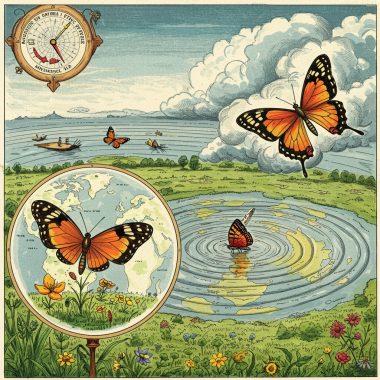Playing God with the Sun: The Dangerous Plot to Dim the Skies
The United Kingdom is preparing to launch experiments in “solar radiation management,” a fancy way of saying that it plans to dim the sunlight that reaches the earth. Usually, announcements of this nature by governments is merely an admission that such activities have been going on for some time.
Now, this raises serious concerns, beginning with the most basic one: consent. No public vote was held anywhere in the world. No widespread public awareness or information campaign was launched. Anyone here in the U.S ask you if you wanted to be sprayed with heavy metals or whatever else is part of these geoengineering experiments?
People in the United Kingdom, the United States, Canada, Australia, and beyond were not asked if they agreed to any of this. Without informed consent, these “experiments” feel more like a top-down decision made by elites than a democratic scientific effort. Sounds a lot like the big COVID experiment, doesn’t it?
Sunlight: The Foundation of Life
Look, sunlight is not just nice to have; it is absolutely essential for life. Plants use sunlight through photosynthesis to produce food and release oxygen. If we reduce sunlight, we are absolutely reducing photosynthesis.
Less photosynthesis means less food, more carbon dioxide in the atmosphere, and less oxygen for humans and animals to breathe. In short, tampering with full-spectrum sunlight will damage the earth’s food supply and fundamental life processes at all levels.
Photosynthesis naturally removes carbon dioxide from the atmosphere. Ironically, the stated goal of sun-dimming is to fight global warming by limiting sunlight, but if photosynthesis slows down, more carbon dioxide will remain in the atmosphere… doing the exact opposite of what these experiments intend.
Food Control is People Control
Who will control the remaining food when food production drops because of less sunlight? This loss of control over our food supply is not just a theoretical concern. Historically, controlling food supplies has always meant controlling populations. For more on how elites have historically controlled societies from the top down… read Plato’s Republic. This is not new.
Further, in ancient sieges, armies would surround cities and starve them into surrender. The idea that global elites or governments could influence food production by controlling sunlight is not just a disturbing science fiction plot… it is a real-world concern we can’t ignore.
Risks to Global Weather and Stability
The risks of politicians manipulating sunlight go far beyond local gardens or vitamin D levels. Changing how much sunlight reaches different parts of the earth could disrupt vital weather patterns like the Asian monsoons, which feed billions of people.
If monsoons are altered or fail, it could trigger mass famine, migration, and even global wars over food and water. The prospect of such conflicts should be a cause for serious concern. Do we have any long-term studies on these shenanigans?
A Delicate Ecosystem Under Threat

Our natural ecosystem is a masterpiece of unimaginable complexity. Plants, animals, fungi, bacteria, and viruses form a delicate web of life, all powered by the sun’s full-spectrum energy.
Every small change can create ripple effects, known as “butterfly effects,” where one tiny shift leads to massive unexpected consequences. Dim the sun even a little, and we could unleash chaotic, runaway changes in weather, biodiversity, and the balance of life itself.
The potential for such chaos should be a cause for serious concern.
Biodiversity and Human Health at Risk
Reduced sunlight would likely decrease biodiversity. Already, human activities have caused the loss of many species, and losing even more would limit future discoveries, medicines, and food sources. Sunlight also plays a critical role in human health, including the production of vitamin D and even mood regulation.
Reducing sunlight could worsen the widespread problem of vitamin D deficiency and increase rates of seasonal depression, dementia, pain from inflammation, and even hair loss. Sunlight’s ultraviolet rays naturally disinfect the environment, helping control harmful bacteria and viruses. Less sun could mean more disease.
Who Gets to Decide?
One of the most disturbing parts of this project is the question of decision-making. Who authorized such massive experiments on the environment? It’s already going on in the U.S. We all know it. Just look up.
In the United Kingdom, the Advanced Research and Invention Agency, which is part of the government, is funding this “high-risk” research.
Key figures like Patrick Vallance, a former government scientific adviser during the COVID lockdowns and now Minister for Science, are involved. Given past “mistakes” and the lack of accountability in large government-led scientific projects, many citizens are uneasy about trusting these leaders with something as critical as sunlight.
You also have to ask yourself, is the UK getting too much sun? I looked up sunlight numbers in the UK and a few other places and found this:comparison of average annual sunshine hours in Great Britain with other regions around the world:
- Great Britain (UK): Approximately 1,500 hours per year.
- Northern Europe (e.g., Norway, Sweden): Similar to or slightly less than the UK, with around 1,400-1,800 hours per year.
- Southern Europe (e.g., Spain, Italy): Significantly more sunshine, with around 2,500-3,000 hours per year.
- North America (e.g., United States, Canada): Varies greatly by region. For example:
- Yuma, Arizona: Over 4,000 hours per year (one of the sunniest places on Earth).
- Seattle, Washington: Around 2,300 hours per year.
- New York City: Around 2,500 hours per year.
- South America (e.g., Brazil, Argentina): Also varies greatly. For example:
- São Paulo, Brazil: Around 2,200 hours per year.
- Buenos Aires, Argentina: Around 2,000 hours per year.
- Africa (e.g., Egypt, South Africa): Generally very sunny. For example:
- Aswan, Egypt: Over 3,800 hours per year.
- Cape Town, South Africa: Around 3,100 hours per year.
- Asia (e.g., India, Japan): Varies greatly. For example:
- New Delhi, India: Around 2,800 hours per year.
- Tokyo, Japan: Around 1,800 hours per year.
- Australia: Generally very sunny. For example:
- Perth: Around 3,200 hours per year.
- Sydney: Around 2,600 hours per year.
- Equatorial Regions (e.g., Ecuador, Kenya): Very sunny, with some of the highest sunshine hours in the world. For example:
- Quito, Ecuador: Around 2,000 hours per year (though it can feel much sunnier due to the intensity of the sun).
- Nairobi, Kenya: Around 2,500 hours per year.
These comparisons highlight that Great Britain receives a low amount of sunshine compared to other regions of the world, with most regions receiving significantly more sunshine hours per year.
So… is the UK (Great Britain) getting too much sun? You decide.
Simpler, Safer Solutions
If reducing carbon dioxide is truly the goal, there are simpler and safer methods. Plant more trees. Encourage natural farming and reforestation.
Restore marine plankton populations, which absorb carbon dioxide and produce oxygen. Instead of high-tech experiments with untested and unpredictable results, why not work with nature rather than against it?
Let’s Wake Up and Look Up
The bottom line is that ecosystems… and the human body… are far too complex for us to fully understand. Acting with political and elitist arrogance… assuming we can control nature without consequences has never ended well.
Instead of charging ahead with dangerous experiments, governments around the world need to be pressed by voters to act with humility, respect the natural world, and above all… prioritize the consent and safety of their citizens. Think about your kids and grandkids.
The future of life on earth depends on full-spectrum sunlight.









